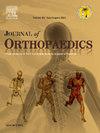俯卧位站立超伸侧位x线片与全长脊柱计算机断层扫描在有症状的陈旧性骨质疏松性胸腰椎骨折伴后凸畸形患者脊柱柔韧性评估中的应用:比较分析
IF 1.5
Q3 ORTHOPEDICS
引用次数: 0
摘要
背景准确评估胸腰椎后凸(TLK)柔韧性对于表现后凸畸形的有症状的老年性骨质疏松性胸腰椎骨折(so-OTLF)患者的术前规划至关重要。虽然使用了传统的站立超伸侧位x线片(SHLR),但与俯卧位计算机断层扫描(CT)在矢状面侦察视图的比较分析仍然有限。本研究旨在评估和比较俯卧位SHLR和全长脊柱CT (FLS-CT)扫描视图评估so-OTLF患者TLK灵活性的有效性。方法回顾性分析行后路矫形融合手术的so-OTLF合并后凸畸形患者。矢状面参数由两名脊柱外科医生独立测量,使用站立x线片、SHLR和俯卧FLS-CT侦察视图。TLK灵活性被量化为站立与SHLR或FLS-CT测量之间的差异。采用配对t检验比较过伸位和俯卧位的矢状Cobb角和TLK灵活性。使用类内相关系数(ICC)评估观察者内部和观察者之间的信度。结果纳入34例患者,平均年龄66.1±7.2岁,女性30例。站立x线片平均TLK为50.9°±13.8°。SHLR显示TLK平均降低7.8°(95% CI: 6.6°-9.1°)至43.1°±12.6°(P <;0.05)。FLS-CT显示平均TLK为31.8°±12.4°,与站立x线片相比减少19.1°(95% CI: 17.4°-20.9°)(P <;0.05)。俯卧位TLK灵活性显著高于过伸位(平均差:11.3°,P <;0.001)。SHLR和FLS-CT均表现出较高的观察者内部和观察者之间的信度(ICC >0.82),与SHLR(观察者内部ICC: 0.97,观察者之间ICC: 0.94)相比,FLS-CT表现出更高的信度(观察者内部ICC: 0.90,观察者之间ICC: 0.82)。结论与传统的SHLR相比,sprone FLS-CT扫描视图可以更准确地评估so-OTLF和后凸畸形患者的TLK灵活性。这种准确性的提高有助于改善术前评估和手术计划。本文章由计算机程序翻译,如有差异,请以英文原文为准。
Application of standing hyperextension lateral radiograph and full-length spine computed tomography scout view in the prone position in spinal flexibility assessment for patients with symptomatic old osteoporotic thoracolumbar fracture with kyphotic deformity: A comparative analysis
Background
Accurate assessment of thoracolumbar kyphosis (TLK) flexibility is paramount in preoperative planning for patients with symptomatic old osteoporotic thoracolumbar fractures (so-OTLF) exhibiting kyphotic deformity. While conventional standing hyperextension lateral radiographs (SHLR) are utilized, comparative analyses with prone computed tomography (CT) scout views in the sagittal plane remain limited. This study aims to evaluate and compare the efficacy of SHLR and full-length spine CT (FLS-CT) scout views in the prone position for assessing TLK flexibility in so-OTLF patients.
Methods
A retrospective analysis was conducted on patients with so-OTLF and kyphotic deformity who underwent posterior corrective fusion surgery. Sagittal parameters were measured independently by two spine surgeons using standing radiographs, SHLR, and prone FLS-CT scout views. TLK flexibility was quantified as the difference between standing and either SHLR or FLS-CT measurements. Paired t-tests were employed to compare sagittal Cobb angles and TLK flexibility between hyperextension and prone positions. Intra- and interobserver reliability were assessed using the intraclass correlation coefficient (ICC).
Results
Thirty-four patients (mean age 66.1 ± 7.2 years, 30 females) were included. The mean TLK on standing radiographs was 50.9° ± 13.8°. SHLR demonstrated a mean TLK reduction of 7.8° (95 % CI: 6.6°–9.1°) to 43.1° ± 12.6° (P < 0.05). FLS-CT revealed a mean TLK of 31.8° ± 12.4°, a reduction of 19.1° (95 % CI: 17.4°–20.9°) compared to standing radiographs (P < 0.05). TLK flexibility in the prone position was significantly higher than in the hyperextension position (mean difference: 11.3°, P < 0.001). Both SHLR and FLS-CT demonstrated high intra- and interobserver reliability (ICC >0.82), with FLS-CT exhibiting superior reliability (intraobserver ICC: 0.97, interobserver ICC: 0.94) compared to SHLR (intraobserver ICC: 0.90, interobserver ICC: 0.82).
Conclusions
Prone FLS-CT scout views provide a more accurate assessment of TLK flexibility in patients with so-OTLF and kyphotic deformity compared to conventional SHLR. This enhanced accuracy may facilitate improved preoperative evaluation and surgical planning.
求助全文
通过发布文献求助,成功后即可免费获取论文全文。
去求助
来源期刊

Journal of orthopaedics
ORTHOPEDICS-
CiteScore
3.50
自引率
6.70%
发文量
202
审稿时长
56 days
期刊介绍:
Journal of Orthopaedics aims to be a leading journal in orthopaedics and contribute towards the improvement of quality of orthopedic health care. The journal publishes original research work and review articles related to different aspects of orthopaedics including Arthroplasty, Arthroscopy, Sports Medicine, Trauma, Spine and Spinal deformities, Pediatric orthopaedics, limb reconstruction procedures, hand surgery, and orthopaedic oncology. It also publishes articles on continuing education, health-related information, case reports and letters to the editor. It is requested to note that the journal has an international readership and all submissions should be aimed at specifying something about the setting in which the work was conducted. Authors must also provide any specific reasons for the research and also provide an elaborate description of the results.
 求助内容:
求助内容: 应助结果提醒方式:
应助结果提醒方式:


